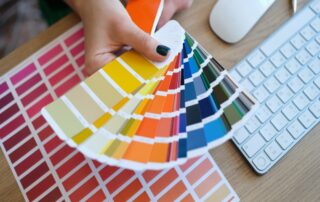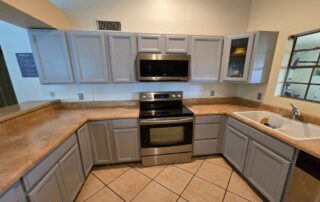Interior painting has now become widely popularly, attuned to the burgeoning Do-It-Yourself or DIY videos on the internet.
It could be all fun and enjoyable not until you encounter the peskiest painting problems.
So if you’re about to pick up your paintbrush and get the work done, be sure to give this a read first and we help you spruce up your home like a pro and say goodbye to these painting dilemmas.
Without further delay, here are tips on How to Fix Common Interior Paint Problems and How To Fix Them in Peoria, AZ.
Cracking and Flaking
Crack attacks are apologetically familiar painting problems as they are primarily caused by insufficient surface preparation.
They can also be a result of applying paint too thinly hence causing the paint to split.
In a different circumstance, cracks also appear due to age.
Paint also becomes brittle over time, making it less adaptive to changes in temperature and humidity.
Repair and Prevention
If damage is extensive, repainting the entire surface might be required but if not, here are the right technique on how to deal with a poorly painted surface:
- Using a scraper, heat gun, wire brush, or chemical application (depending on the severity of the cracks), remove all of the cracked and flaking paints.
- Properly clean and prime the surface.
- Repaint the problem spots. Be wary on how you load the brush or roller with paint in order to avoid too-thin or too-thick application.
- To those who are using a brush, only dip one-third of the bristle length to the paint; then tap the brush lightly on both sides, and refrain from dragging it against the edge of the container.
- To those who a roller, fill the roller tray midway. Remove the lint from a new roller cover, dip the roller into the tray’s well, then roll over the ribbed area of the tray several times to uniformly spread the paint.
Blistering or Bubbling
Moisture could be cited as the main culprit that can push the paint off the surface.
When put over a damp surface or over water-based (latex) paint, oil-based paint is prone to blistering.
Blistering can also be caused by painting over a dirty surface, not using primer, or using incorrect techniques.
Repair and Prevention
- When you pop the blisters and it reveals a bare substrate, it could be caused by a moisture issue. To fix this, may consider doing repairs for your plumbing, or you can also replace caulking, and/or increase ventilation.
- You may proceed in removing the blistered paint, then sand smooth the surface, clean, apply prime, and lastly, repaint.
- Always stir the paint in slow motion. Stirring it too quickly may cause the paint to bubble that may transfer to the painting surface.
- If you detect bubbles during paint application, slow your stroke speed.
Peeling
Peeling of paints could be blamed on excessive moisture, but it can also be caused by overzealous showering, cooking, and humidifier use.
Repair and Prevention
- Create a less peel-prone environment inside by improving interior ventilation as needed with exhaust fans, wall vents, and/or louvers.
Alligatoring
Taken from its name, alligatoring is a paint problem that refers to a pattern that resembles reptilian skin.
It starts as subtle wrinkling which turns into rectangular and wide cracks.
Repair and Prevention
- To fix this dilemma, remove unsightly scales by using the different methods of scraping, sanding, applying chemical removers, or using a heat gun.
- Then rinse the surface to banish the dust and let it dry completely.
- Once done, prime the surface, wait for it to dry, and repaint.
Efflorescence or Mottling
This paint problem emerges when salts in brick, cinderblock, concrete, and mortar break down in moisture and subsequently seep out to the surface.
Repair and Prevention
- It is recommended to tackle this paint problem on a warm or sunny day. Remove excess moisture externally by repairing cracks and waterproofing.
- To remove efflorescence, you may need to use a combination of these equipment (depending on the extent and severity): scraper, wire brush, low-pressure washer, diluted white vinegar, or a trisodium phosphate (TSP) solution.
- Ensure to wear protective gear when dealing with chemicals and then rinse thoroughly.
- It is further advisable to use colorless water repellents as they may prevent efflorescence from recurring.
- Lastly, allow it to dry completely before repainting.
If you are in Arizona and need a painter or painting contractor you can trust, contact Prime Painting at 602-902-1584 for a FREE Estimate today! Or book online!
Our team has over 380 5-Star Reviews!
Related: Interior Paint Color Selection Tips in Phoenix, AZ
Interior Painting Trends to Elevate Your Style in Peoria, AZ



